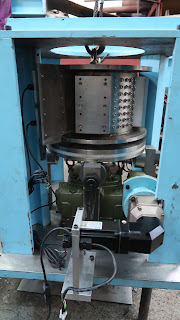Here is the room that is attached to our rig room. When you enter, it feels like you've gone back in time, or you've entered a museum dedicated to machine shops of yore... and I absolutely fell in love with it from the first time I saw it.
That garage door opens up to an open outdoor space. I imagine hanging twinkling lights on the open door and having barbecues on Thursday afternoons, cold beers sitting in a bucket of ice...
Nobody needs that many giant cutters, but don't they look cool displayed on the wall? The one-ton overhead crane runs the length of the lab.
The welding station could be a movie set piece.
But although I told them "Don't you dare paint the walls or floor or take that crane out..." we do need some improvements to be made. We were still midstream on many of these when we got the order to stop work at Lamont, but I will share what's been done so far.

First task was to break down everything metal, clean it, sand it and paint it black. Starting to look good.
Got my hands on someone's wood countertop that they decided not to put in their kitchen. Mike reinforced the bottom so it wouldn't bow and we put it up on painted black legs.
And finally transferring all of the pressure fittings and gear from the old lab to the new lab, including labeling the drawers. Getting there. When we get back in, we'll put up a big industrial clock and some unistrut shelves on the back wall. Oh, I can't wait to get back in there!











































